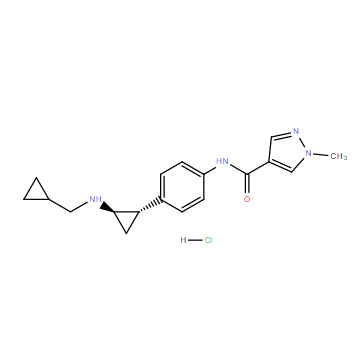| Cas No.: | 1422535-52-1 |
| Chemical Name: | T-3775440 (hydrochloride) is an irreversible lysine-specific histone demethylase (LSD1) inhibitor with an IC50 value of 2.1 nM. |
| Synonyms: | T 3775440;T3775440 |
| SMILES: | N(C)1C=C(C(NC2=CC=C([C@H]3C[C@@H]3NCC3CC3)C=C2)=O)C=N1.[H]Cl |
| Formula: | C18H23ClN4O |
| M.Wt: | 346.859 |
| Purity: | >98% |
| Sotrage: | 2 years -20°C Powder, 2 weeks 4°C in DMSO, 6 months -80°C in DMSO |
| Description: | T-3775440 (hydrochloride) is an irreversible lysine-specific histone demethylase (LSD1) inhibitor with an IC50 value of 2.1 nM. |
| Target: | IC50: 2.1 nM (LSD1)[1]. |
| In Vivo: | T-3775440 upregulates CD86 mRNA expression in tumor xenografts of HEL92.1.7 cells in a dose-dependent manner following the oral administration of single doses ranging from 3 to 30 mg/kg. To investigate target engagement of this compound in tumors, PI16 expression levels is tested as a direct biomarker. As expected, PI16 suppression is dramatically reversed by T-3775440 treatment. In a TF-1a (AEL) tumor xenograft model, T-3775440 exhibits significant antitumor effects, with 15-day T/C values of 15.6% and <0% at doses of 20 and 40 mg/kg, respectively. T-3775440 also exhibits potent antitumor effects in an additional AEL model of HEL 92.1.7 and an AMKL model of CMK11-5, leading to nearly complete tumor growth suppression during the dosing period. It is found that in mice, T-3775440 treatment results in a transient reduction in platelets, followed by a significant rebound; this is considered a mechanism-based adverse effect of LSD1 inhibition. On a dosing schedule comprising 5 days on/2 days off, a statistically significant difference in body weight is observed between vehicle- and T-3775440–treated tumor xenograft model mice at higher doses. However, efficacious T-3775440 doses are tolerated in all subcutaneous tumor xenograft models[1]. |
| In Vitro: | T-3775440 demonstrates irreversible inhibition of recombinant human LSD1, with a kinact/KI value of 1.7×105 (sec−1 M−1). T-3775440 is highly selective for LSD1 relative to other monoamine oxidases (e.g., MAO-A and MAO-B), with an IC50 value of 2.1 nM). T-3775440 blocks the proliferation of several cell lines as quickly as day 3 of treatment. Notably, the granulocyte/macrophage markers CD86 and CD11b are commonly upregulated on both TF-1a and HEL92.1.7 cells in response to T-3775440 treatment, whereas the erythroid markers CD235a and CD71 are downregulated by this treatment. In CMK11-5 cells, CD86 mRNA expression is also clearly upregulated by T-3775440 in a concentration-dependent manner, although only a modest increase in cell surface CD86 expression is observed. T-3775440 treatment disrupts the LSD1-GFI1B association in a concentration-dependent manner. T-3775440 decreases LSD1 binding but not GFI1B binding and increases the level of dimethylated H3K4 at the PI16 locus[1]. |
| Cell Assay: | The human leukemia cell lines TF-1a, HEL92.1.7, CMK11-5 and M07e are used. All cells are grown in RPMI1640 plus 10% FBS and maintained in a humidified incubator at 37°C and 5% CO2. To assess cell proliferation and viability in human leukemia cell lines, compounds (e.g T-3775440) are added with different concentrations (T-3775440: 0, 10, 50 nM) at 24 h after cell seeding. After the incubation period, cells are lysed with CellTiter-Glo, and luminescent signals are detected using an ARVO MX1420 microplate reader. For cell-cycle analysis, cells are fixed overnight with 70% ethanol. Fixed cells are stained with propidium iodide and analyzed on a FACSCalibur or FACSVerse flow cytometer[1]. |
| Animal Administration: | Mice[1] Female C.B17/Icr-scid/scid Jcl mice are used and maintained under specific pathogen-free conditions. AML cells (2×106 cells) in Matrigel are inoculated subcutaneously into the left flanks of 6- to 7-week-old mice (day 0). Mice are randomized when the mean tumor volume reached approximately 150 to 350 mm3. Subsequently, mice are administrated with vehicle or T-3775440 single doses ranging from 3 to 30 mg/kg once daily on 5 days on/2 days off schedule for 2 weeks. Twice weekly, tumors are measured with vernier calipers, and tumor volumes are calculated[1]. |
| References: | [1]. Ishikawa Y, et al. A Novel LSD1 Inhibitor T-3775440 Disrupts GFI1B-Containing Complex Leading to Transdifferentiation and Impaired Growth of AML Cells. Mol Cancer Ther. 2017 Feb;16(2):273-284. |

 DC Chemicals' products qualify for U.S. tariff exemptions. We guarantee no price increases due to customs duties and maintain stable supply, continuing to deliver reliable research solutions to our American clients.
DC Chemicals' products qualify for U.S. tariff exemptions. We guarantee no price increases due to customs duties and maintain stable supply, continuing to deliver reliable research solutions to our American clients.





















